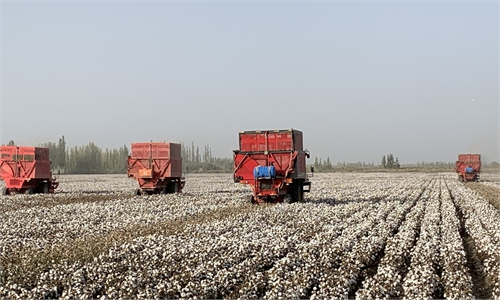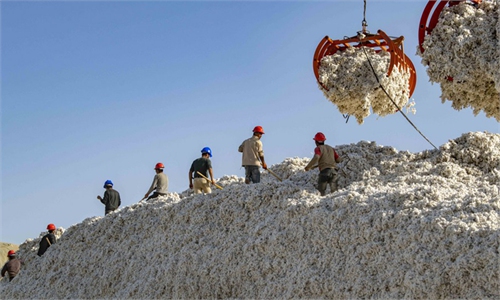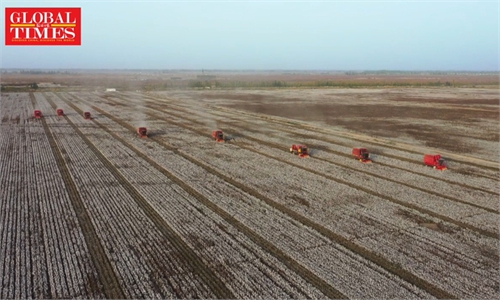Xinjiang harvests first China-standard cotton
Cotton standards to counter Western monopoly, restore fairness
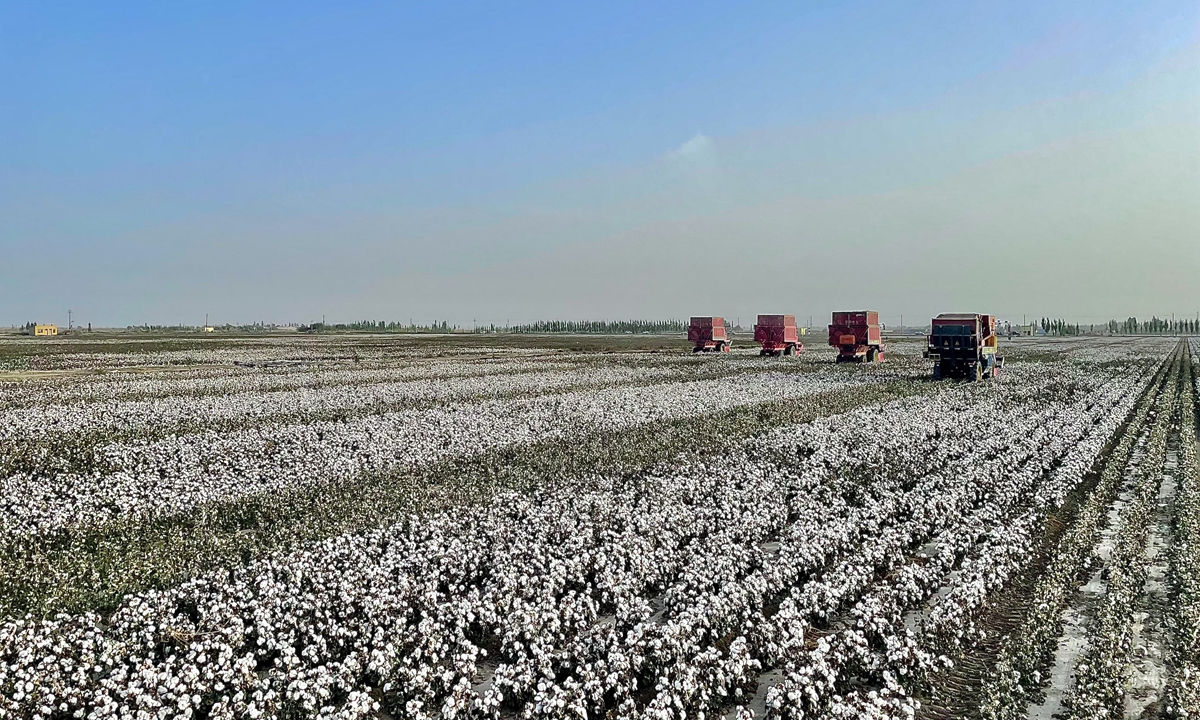
A domestically-developed automatic cotton-picking machine fleet at work in Shaya county, Aksu Region, Northwest China's Xinjiang Uygur autonomous region. Photo: Lin Luwen/GT
At an endless cotton field located at the southern hills of the Tianshan Mountains in Northwest China's Xinjiang Uygur Autonomous Region, workers from China's cotton industry association were busily inspecting the field, screening quality for fresh picked cotton and processing product certification.The 70,000-mu (4,666 hectares) of cotton field marks the first batch of cotton that was planted and managed under China's homegrown independent sustainable cotton standard as Xinjiang, which accounts for more than 85 percent of China's cotton output, is embracing another bumper harvest season.
The field is owned by Xinjiang Guoxin Seed Co, one of the first six Xinjiang cotton producers that signed contracts with the China Cotton Association (CCA) in April in the launch and promotion of the "Cotton China Sustainable Development Program" - deemed as a critical mechanism to counter Western dominance.
"In Xinjiang, we have felt a sense of urgency to speed up setting up our own standard and building homegrown cotton brand. China is the world's largest cotton producer and consumer, yet we face constraints and have been bullied by Western forces partly due to the lack of a unified and globally influential standard," Liu Wenming, a local agricultural official in southern Xinjiang's Shaya county, told the Global Times over the weekend. Shaya represents 90 percent of China's long-staple cotton yield.
The global cotton rule-making system is currently monopolized by the Better Cotton Initiative (BCI), a Western-led industry body that has apparently been manipulated by anti-China forces.
Several months ago, BCI suspended cotton license for Xinjiang companies over claimed "forced labor," based upon which some BCI's members joined the boycotts, leading to an almost standstill of Xinjiang's cotton and textile exports. The targeted attack faced a tsunami of anger and an ensuing backlash among the Chinese and international community, and was harshly criticized for not only attempting to damage Xinjiang but also jeopardizing the legitimate development rights of Xinjiang people.
The Western-led boycotts against Xinjiang cotton also fueled calls from industry insiders to establish a Chinese standard that is more inclusive and lives to the highest industry standard to counter BCI's slandering and advocate fair treatment of Xinjiang farmers.
The Cotton China Sustainable Development Program was created in response, and the first six producers signed were all large-scale Xinjiang agricultural companies. A spokesperson from CCA also told the Global Times that in late October, more Chinese textile-makers and clothing brands will sign contracts to join the standard-setting.
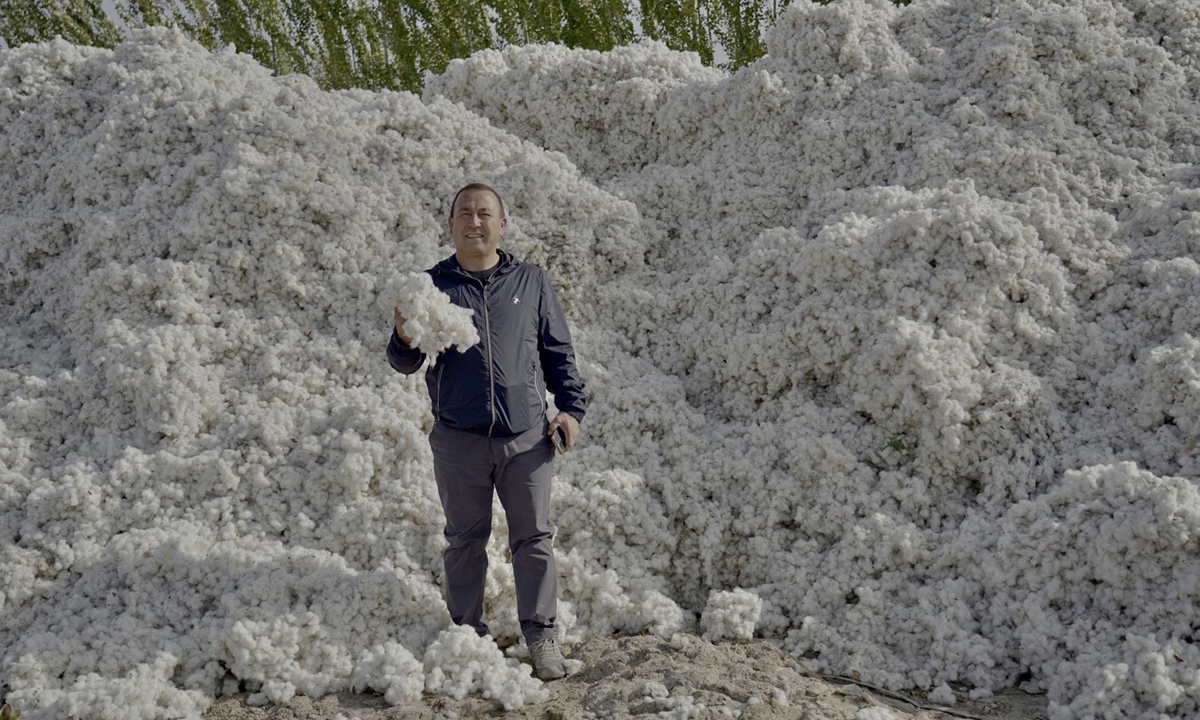
A cotton farmer in Shaya county harvested about 2 tons of cotton from his plantation. Photo: Lin Luwen/GT
Cotton standards
Li Lin, the vice secretary of CCA, told the Global Times over the weekend that the Cotton China Sustainable Development Program has specific management standards for reducing pollution, energy conservation and emission reduction, respect for labor and quality improvement.
"Farmers are all required to make up a sustainable planting and management plan at the beginning of the year, and are required to do an on-field log on every farming procedure, from seeding, fertilizing, spraying pesticide to applying agricultural technique," Li explained, while showing a detailed and traceable cotton farming plan submitted by Xinjiang Guoxin Seed Co.
Under the plan, farmers will test soil for fertilization levels, vowing to cut the amount of fertilizers used in cotton production. In terms of seeding, farmland will be planted with new high-quality crop seed that guarantees both high yield and disease resistance. And individual farm will be planted with a single crop seed to ensure varietal purity.
Meanwhile, the plan explicitly pledged to promote intelligent management of cotton fields, including multi-purposed seeders, plantation drones and cotton pick machines, to improve quality and yield for the long-term sustainable development of the industry.
Discussing the program, Liu said that one of Shaya county's focal agricultural works since the start of this year is to unify the plantation of a single cotton seed and expand massive farming.
"The coverage rate of the main cotton seed in Shaya has reached 92 percent this year, effectively reversing the issue of inconsistency of raw cotton that dragged down the overall cotton quality," Liu said.
"In the past, we were pursuing higher yield, which inevitably led to our reputation being inferior to some other global competitors such as cotton sourced from the US. But now our focus has shifted to promoting quality, and the transformation will accelerate the internalization of Xinjiang cotton and improve its global competitiveness," he added.
The harvested cotton from Guoxin's field, whose farming was strictly drawing upon the new standard, has delivered "good performance in multiple dimensions including length, strength and micronaire," according to Lu Huaiyu, the head of Guoxin's rural technological service bureau. Micronaire is a measure of the air permeability of compressed cotton fibers.
If these cotton passes certification, it will enter the textile manufacturing procedure as the first batch of "China Sustainable Cotton" and being delivered to consumers through retailers.
"This is just a start. We will continue promoting the standard to downstream enterprises and consumers, to build a complete industrial chain and form a virtuous circle," Li told the Global Times.
Cotton output is expected to hit 5.2 million tons in Xinjiang this year, slightly up from the 5.16 million tons recorded last year.

